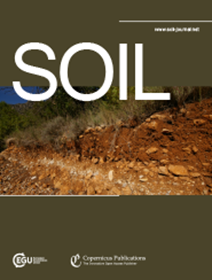样品处理导致普通土壤碳测量误差较大
IF 5.8
2区 农林科学
Q1 SOIL SCIENCE
引用次数: 0
摘要
摘要。要建立对土壤碳(C)入计量计划有效性的信心,土壤有机碳 C(SOC)的精确量化至关重要。要检测管理转变后土壤有机碳(SOC)的真实变化(尤其是在农田中)是很困难的,因为这需要强有力的土壤采样和土壤处理程序。只有通过可靠的土壤碳测量和估算,才能对不同时空尺度进行有意义的信息比较。为了衡量土壤碳测量的相互可变性,我们对根据碳市场 SOC 定量的地位和参与情况选出的 8 家实验室进行了盲法外部服务实验室比较。为了更好地了解土壤测试实验室常用的土壤处理程序和定量方法对土壤碳浓度测量的影响,我们设计了一个内部实验,评估几种替代程序(即筛分、细磨和干燥)和定量方法对土壤总碳浓度(TC)、无机碳浓度(SIC)和有机碳浓度(SOC)估算值的影响。我们对 12 种不同的农业土壤进行了分析,使用了 11 种程序,这些程序在筛分、精细研磨、干燥或定量步骤上各不相同。我们发现,机械研磨机是服务实验室最常用的筛分方法,但它不能有效去除粗大物质(如根茎和岩石),因此与其他筛分方法(即 8 + 2 毫米、4 毫米和用擀面杖擀成 2 毫米)相比,可变性更高,碳浓度测量结果也有显著差异。较细的研磨通常会导致较低的方差系数,其中最细研磨至 125 µm 的方差系数最低,其次是 250 µm 的研磨,最后是 2000 µm 的研磨。由于水分去除不充分,在进行元素分析前未将土壤放入烘箱(105 °C)中烘干平均导致 TC 和 SOC 的相对差异分别降低了 3.5% 和 5%。在我们的研究中,TC% 是通过元素分析仪上的干燃烧定量的,SIC% 是通过压力传感器测量的,SOC% 是通过 TC% 和 SIC% 的差值计算的。与此参考方法相比,使用傅立叶变换红外光谱法对所有三种土壤特性(TC%、SIC%、SOC%)的预测结果都非常一致(R2 分别为 0.97、0.99、0.90)。就 SOC%而言,用点燃损失法进行定量的方差系数较低(5.42 ± 3.06 %),但与参考方法的一致性最低(R2 = 0.83)。本文章由计算机程序翻译,如有差异,请以英文原文为准。
Large errors in common soil carbon measurements due to sample processing
Abstract. To build confidence in the efficacy of soil carbon (C) crediting programs, precise quantification of soil organic carbon C (SOC) is critical. Detecting a true change in SOC after a management shift has occurred, specifically in agricultural lands, is difficult as it requires robust soil sampling and soil processing procedures. Informative and meaningful comparisons across spatial and temporal time scales can only be made with reliable soil C measurements and estimates, which begin on the ground and in soil testing facilities. To gauge soil C measurement inter-variability, we conducted a blind external service laboratory comparison across eight laboratories selected based on status and involvement in SOC quantification for C markets. To better understand how soil processing procedures and quantification methods commonly used in soil testing laboratories affect soil C concentration measurements, we designed an internal experiment assessing the individual effect of several alternative procedures (i.e., sieving, fine grinding, and drying) and quantification methods on total (TC), inorganic (SIC), and organic (SOC) soil C concentration estimates. We analyzed 12 different agricultural soils using 11 procedures that varied either in the sieving, fine grinding, drying, or quantification step. We found that a mechanical grinder, the most commonly used method for sieving in service laboratories, did not effectively remove coarse materials (i.e., roots and rocks), thus resulted in higher variability and significantly different C concentration measurements from the other sieving procedures (i.e., 8 + 2 mm, 4 mm, and 2 mm with rolling pin). A finer grind generally resulted in a lower coefficient of variance where the finest grind to < 125 µm had the lowest coefficient of variance, followed by the < 250 µm grind, and lastly the < 2000 µm grind. Not drying soils in an oven (at 105 °C) prior to elemental analysis on average resulted in a relative difference of 3.5 % lower TC, and 5 % lower SOC due to inadequate removal of moisture. Compared to the reference method used in our study where % TC was quantified by dry combustion on an elemental analyzer, % SIC was measured using a pressure transducer, and % SOC was calculated by the difference of % TC and % SIC, predictions of all three soil properties (% TC, % SIC, % SOC) using Fourier Transformed Infrared Spectroscopy were in high agreement (R2 = 0.97, 0.99, 0.90, respectively). For % SOC, quantification by loss on ignition had a low coefficient of variance (5.42 ± 3.06 %) but the least agreement (R2 = 0.83) with the reference method.
求助全文
通过发布文献求助,成功后即可免费获取论文全文。
去求助
来源期刊

Soil
Agricultural and Biological Sciences-Soil Science
CiteScore
10.80
自引率
2.90%
发文量
44
审稿时长
30 weeks
期刊介绍:
SOIL is an international scientific journal dedicated to the publication and discussion of high-quality research in the field of soil system sciences.
SOIL is at the interface between the atmosphere, lithosphere, hydrosphere, and biosphere. SOIL publishes scientific research that contributes to understanding the soil system and its interaction with humans and the entire Earth system. The scope of the journal includes all topics that fall within the study of soil science as a discipline, with an emphasis on studies that integrate soil science with other sciences (hydrology, agronomy, socio-economics, health sciences, atmospheric sciences, etc.).
 求助内容:
求助内容: 应助结果提醒方式:
应助结果提醒方式:


